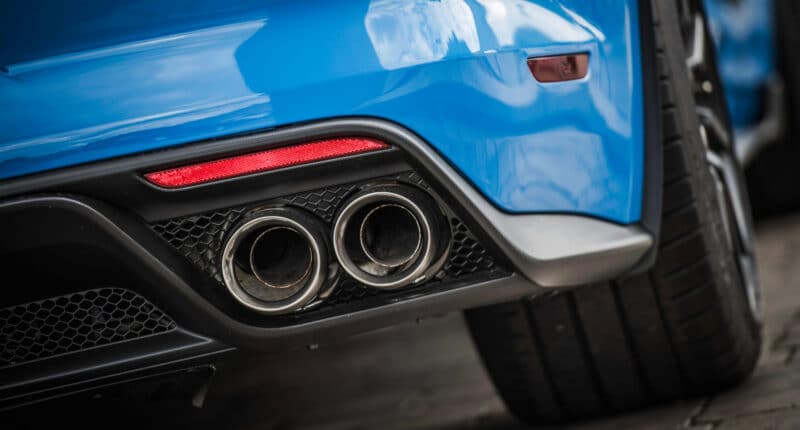Ask any car enthusiast what they’d do with $1000 and a bone stock car — there’s a good chance they’ll choose to install an aftermarket exhaust system.
And why not? It’s a relatively cheap upgrade, can make your car sound great, and frees up a few extra ponies.
But will exhaust mods make your car noticeably faster? Well, not really. In fact, poorly done exhaust upgrades can actually do more harm than good.
Understanding how exhaust systems work will help you choose the right parts when making changes, and it will set the stage for what to expect when modifying your exhaust.
In this article, we’ll explain what exactly an exhaust system does and run through exhaust system design. Finally we’ll look at what happens when you make exhaust mods.
What Does an Exhaust Do?
To understand how exhaust systems work, we need to understand the four-stroke cycle. This is where exhaust gases come from.
- Intake: The intake system delivers air to the combustion chamber/engine cylinder.
- Compression: The piston compresses the air-fuel mixture and reaches top dead center.
- Combustion: The spark plug ignites the compressed air-fuel mixture, and the explosion pushes the piston to bottom dead center.
- Exhaust: The piston travels back up, but this time it pushes the waste gases out of the cylinder head, and the cycle repeats. This is an oversimplification, but you get the idea.
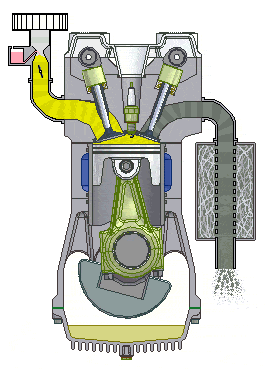
If the exhaust cycle fails and the spent gases do not leave the engine, the subsequent combustion cycle won’t be effective and the engine won’t run correctly.
With that in mind, the primary function of the exhaust system is to rid the engine of waste gases after each stroke.
The system comprises a complex set of piping that carries the gases out of the engine to an exit point at the rear of the car.
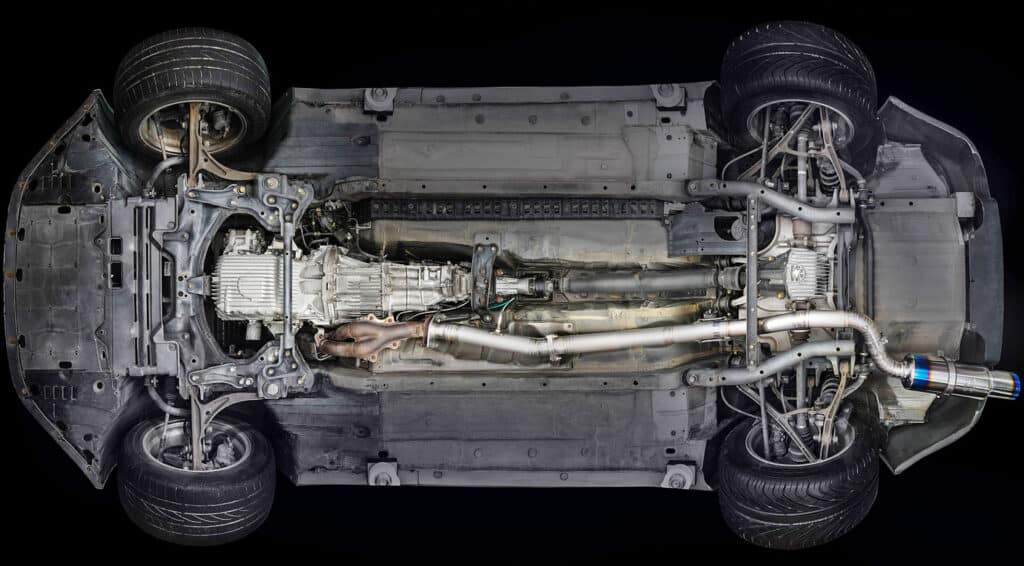
And that’s not all. There’s more:
- The exhaust pipes redirect toxic fumes away from passengers.
- The catalytic converter lowers the toxicity of spent gases.
- The O2 sensor communicates with the ECU to balance out the air-fuel mixture.
- The resonator and muffler work in unison to deliver the ideal exhaust sound.
The result is maximum efficiency, good performance, cleaner emissions, and an acceptable exhaust volume.
Let’s take a closer look at the individual exhaust system components that make all this happen.
Components of Exhaust System Design
The exhaust system is a complex assembly of different parts that work together to achieve the perfect balance of performance and efficiency.
Even though they’re all mechanically simple, they play a very important role in determining your car’s overall performance. And while there are some general rules to how most exhaust systems are designed, no one system is the same.

Let’s take a look at some of the most important exhaust system components.
Headers / Manifold
Your exhaust manifold is where the waste exhaust gases begin their exit journey; it’s the first set of piping in your exhaust system that’s connected directly to the engine.
Its purpose is to collect exhaust gases from each cylinder in your engine and reroute them to the rest of the exhaust system.
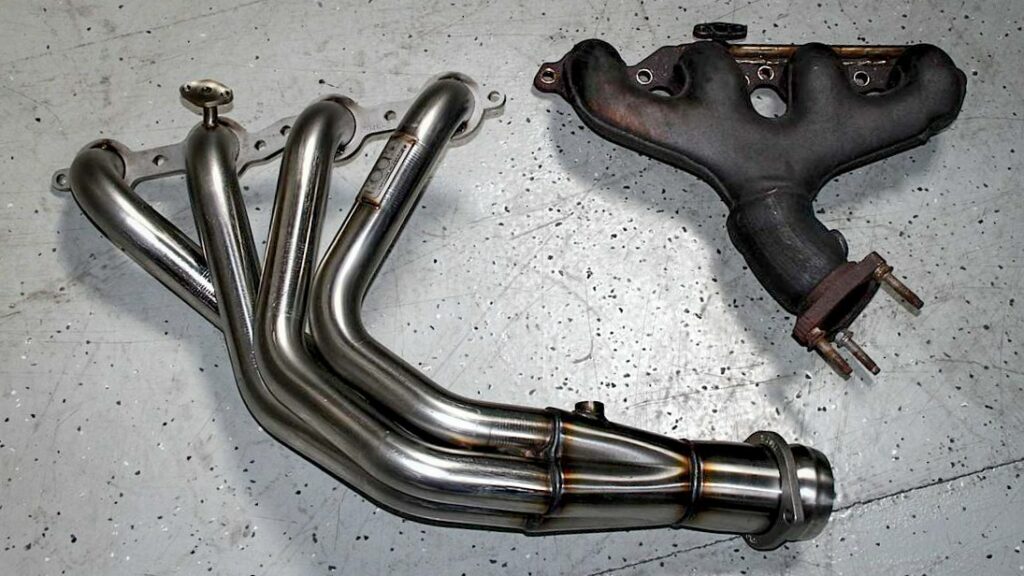
The words “manifold” and “headers” are often used interchangeably. Both these parts do the same thing but differently, and both have their own use cases.
Manifolds are typically installed from the factory because they’re thicker, sturdier, and cheaper to make whereas headers are usually available as an aftermarket part.
Headers are much lighter and are designed for better exhaust scavenging characteristics. These are used in high-performance applications — usually seen on naturally aspirated tuner cars.
O2 Sensor
The O2, oxygen or lambda sensor is a small part of your exhaust system that monitors how much unburned oxygen is present in the exhaust gas as it exits.
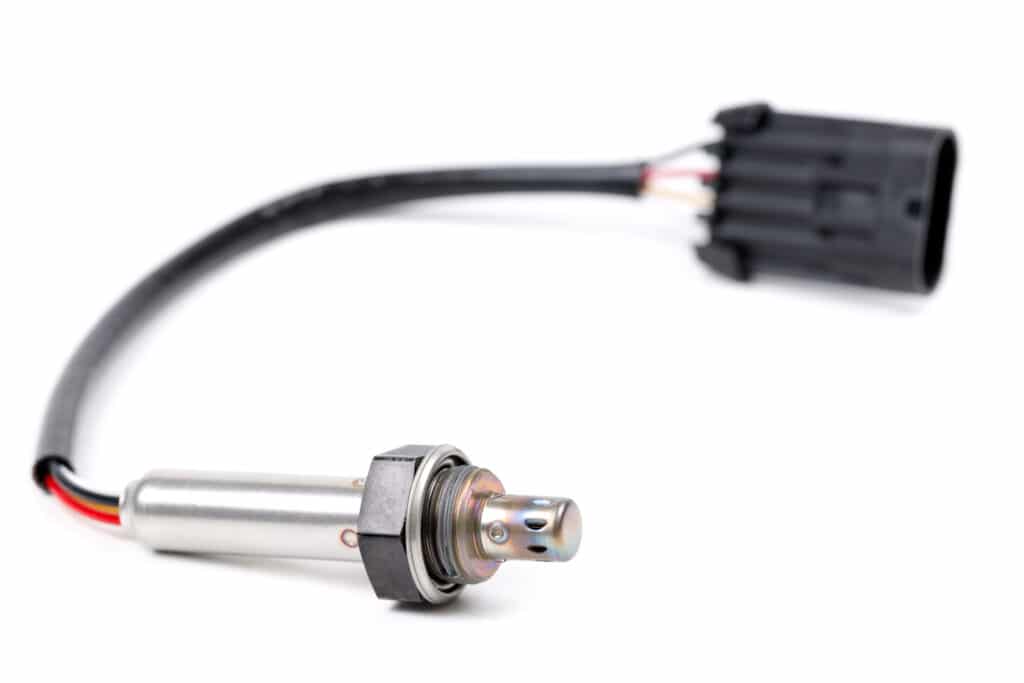
By measuring the amount of unburned oxygen and sending that information to the ECU, these sensors let your car know if it’s running lean or rich. The ECU then uses this information to adjust the air/fuel mixture for better efficiency and performance.
Most modern-day fuel-injected cars use O2 sensors but they’re also seen on some old carbureted cars that featured electronically adjustable jets and an O2 sensor.
Catalytic Converter
This is either the most important or the least important part of your exhaust system depending on your priorities. The catalytic converter — also known as “cat” or “cat-con” — is responsible for converting toxic exhaust pollutants into less-toxic gas before it is expelled into the atmosphere.

The converter houses a ceramic honeycomb structure that is coated with catalysts — usually platinum (Pt), palladium (Pd), and rhodium (Rh).
Exhaust gases flow through the honeycomb structure and come in contact with these catalysts where they oxidize and get reduced to less-toxic fumes.
Resonator
Resonators are like mufflers — their role has more to do with how your exhaust system sounds. To understand how exhaust resonators work, it helps to know what a muffler is.
Mufflers help in reducing the volume or loudness of your exhaust note. Resonators, on the other hand, are “pre-mufflers”.
They morph the engine sound and make it easier for the muffler to actually work with it and achieve a reduction in volume.
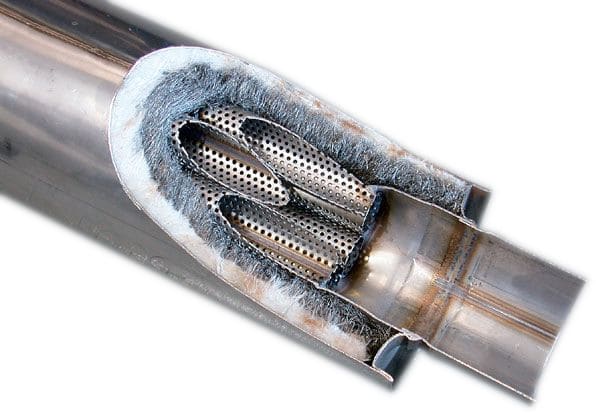
The resonator is like an echo chamber — it optimizes the exhaust pulse frequencies to achieve better fuel efficiency and fine-tunes the sound waves into a more organized pattern.
Muffler
The muffler is engineered like an acoustic device — it houses a series of passages and chambers lined with fiberglass insulation and resonating chambers.
As the name suggests, this car part muffles the exhaust note. Its only purpose is to make your car quieter so that it complies with exhaust noise regulations and doesn’t create an annoying drone while cruising on the highway.

Mufflers vary a great deal in their design. Some are very simple with few elements while some come packed with features for the most perfect note while retaining an ideal flow of exhaust gases.
Things To Know Before Buying an Aftermarket Exhaust
Your stock exhaust isn’t a cobbled-together afterthought. The vast majority of modern cars have a very carefully engineered exhaust system. In fact, the exhaust system typically soaks up most of the R&D resources.
Why then do we switch these precision-tuned exhausts out in favor of aftermarket options?
Contrary to manufacturer claims and popular belief, aftermarket exhaust systems don’t add as much power as you’d think. So is the switch worth it?
The answer is yes — there’s a lot to be gained, but only if you know what you’re doing. To understand why aftermarket exhausts work and what they do differently, it helps to understand core concepts such as exhaust velocity, back pressure, scavenging, and pressure waves.

Exhaust Scavenging
Scavenging refers to the process of replacing spent gases with a fresh charge of air and fuel. This “evacuation” process occurs because of two things:
- The pistons does some of the work by pushing the gases out of the exhaust valve.
- The pressure differential between the engine cylinder and exahust manifold causes the exhaust gases to leave the engine and move towards a low pressure area.
This happens because naturally, all gases tend to travel from areas of low pressure to areas of high pressure.
So when these gases leave the engine, a negative pressure wave follows each exhaust pulse. This negative pressure wave helps to draw out the next exhaust pulse, and the cycle keeps going. This is referred to as exhaust scavenging.
The faster these exhaust gases leave the engine, the more efficient the scavenging process. For this reason, aftermarket exhaust system manufacturers design their exhaust systems to maximizes the scavenging effect.
OEMs do this too, but the stock exhaust design always favors compliance with emissions standards over outright performance. That’s why the stock exhaust system is more restrictive. Now, let’s investigate why “restrictive” is a problem.
Backpressure
Put simply, backpressure is the pressure opposing the desired exhaust flow. Think of it as the exact opposite effect of scavenging.
We’ve mentioned earlier that exhaust gases tend to flow from areas of high pressure to low pressure. The higher the pressure differential, the easier it is for the exhaust fumes to flow out of the cylinder.
You want the pressure in your exhaust system to be as low as possible in order to achieve high volumetric efficiency.
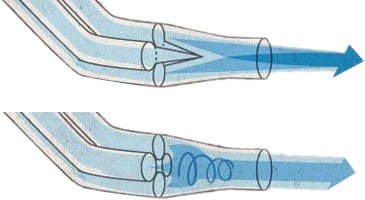
Adding backpressure is only going to lower the pressure differential, making it harder for exhaust gases to escape (poor scavenging). This creates two problems:
- Volumetric efficiency drops, that is, exhaust gases don’t get vented effectively, which means that an insufficient amount of air and fuel gets drawn into the cylinder (there’s only so much space to work with). This reduces power output.
- Because some of the exhaust gases fail to escape, the next combustion cycle gets affected negatively.
With that in mind, backpressure is clearly a bad thing. And guess what causes backpressure — restrictions.
The more restrictive your exhaust system is, the more bends it has, the more backpressure you’re going to get. The reason why aftermarket exhausts are desirable is that it has fewer restrictions compared to your stock setup.
The Relationship Between Pipe Diameter and Exhaust Velocity
Another important aspect to consider is exhaust velocity — it refers to the speed with which exhaust gases are released. Scavenging only works when exhaust gases leave the engine cylinder with enough velocity.
And you’ll only have the right amount of exhaust velocity with the right piping diameter. The larger your exhaust pipe is, the lower your exhaust velocity will be.
That’s the reason why you can’t simply install a 6” pipe and expect power gains. Sure, you’ll lower restrictions with an exhaust that size, but exhaust velocity will drop to a point where there’s little to no scavenging.
The idea is to balance out the restrictions and narrowness of your exhaust. You want high velocity, high scavenging, and minimal restrictions, with as little backpressure as possible.
Final Thoughts — Are Aftermarket Exhausts Worth It?
Consider this — a $4,000 single turbo kit can give you close to 100 more horsepower, but an aftermarket exhaust won’t add any more than 3 to 6 horsepower. That raises the question of whether this modification is worth the money.
Aftermarket exhausts should be looked at as something you install to prepare your car for making more power with upgrades that you’ll install in the future, and not as a standalone mod.
The goal with aftermarket exhaust systems is to remove as many restrictions as possible, reduce backpressure, increase scavenging, and shed some weight.
Whether this upgrade will work for you or not depends on a few things:
- the car you drive,
- how restrictive your stock exhaust system is,
- whether you have any supporting upgrades installed, and
- how good your tuning technician is.
And remember, there’s nothing wrong with installing an aftermarket exhaust system just for the way it sounds and looks.
What are your thoughts on aftermarket exhausts? Would you install one just for the sound? Let us know by leaving a comment below!
